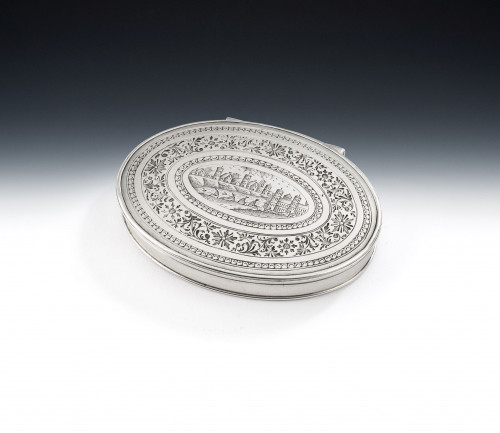- Home
- British Silver 1649-1759
- A very fine George II Tea Caddy and Sugar Box made in London in 1731 by John Newton.
A very fine George II Tea Caddy and Sugar Box made in London in 1731 by John Newton.
A very fine George II Tea Caddy and Sugar Box made in London in 1731 by John Newton.
375364
Both pieces are of a narrow rectangular form and stand on a stepped base. The sides are all flat chased and engraved with outer borders of strapwork, enclosing diaper, festoons, foliate scrolls and very unusual masks, the individual wearing a stylised head dress. The front and reverse are engraved with a contemporary Armorial surrounded by baroque cartouches, raying shells and foliate scrolls. The hinged, bevelled, covers display a flat chased border decorated with raying flower heads and foliate motifs. The cover centres with a cylindrical finial, the top engraved with a beautiful rosette. This cover on the caddy can be removed, as it would double up as a tea measure, however the cover of the sugar box is fixed, as it would not need to ever be removed. Both pieces are in exceptional condition and well marked on the bases. The caddy bearing a full set of marks and the sugar box marked with the sterling mark and maker’s mark three times.
The Armorial is that of Fawkes impaling Atkins of Farnley Hall, County Yorkshire. Thomas Fawkes married Rebecca Maria Atkins of St. Andrews, Holborn on 29th May, 1730, so this was almost certainly made to celebrate their marriage. Thomas was born at Farley Hall and his wife Rebecca was the daughter of Sir Henry Atkins, 3rd Baronet. The family greatly patronised Turner and they still own a number of his paintings and drawings. The Catholic conspirator, Guido (Guy) Fawkes, of the Gunpowder Plot, was descended from the Fawkes family of Farnley Hall and a portrait print is shown.
With regard to the maker, John Newton, he was apprenticed to John Farnell, 5th February, 1719. He entered his first mark as a large worker on 4th April, 1726, with workshops in Staining Lane. He was second in a line of specialist tea caddy makers, the first being his Master John Farnell, and the third being the prolific Samuel Taylor, who was apprentice to him in 1736. Newton had a distinctive maker's mark, all contained in a heart shaped punch.
Height: 3.95 inches, 9.88 cm.
Length: 2.5 inches, 6.25 cm.
Width: 1.65 inches, 4.13 cm.
Weight: 13 oz, the pair.
Thank you for your enquiry.
We will get back to you soon.
Please create wishlist to add this item to
RELATED ITEMS



























